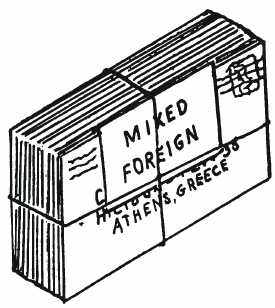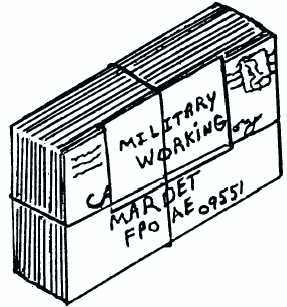| |
half-sized MM trays hold an average of 200 letters.
MM trays should always be filled to maximum
capacity, when possible, but no less than three-fourths
or 75 percent. When full-sized MM trays are less than
75 percent filled, place the mail in half-sized MM
trays.
If the volume of letter mail does not warrant using
MM trays, prepare letter mail in bundles as discussed
earlier and place in Priority Mail No.1 pouches labeled
to the serving USPS CONUS gateway or FMC as your
area mail coordinator so designates.
After the tray is filled, it should be inserted into a
sleeve and secured by a strap. The adhesive-backed label
holder should be attached to the top-left corner of the tray.
Most large shipboard commands use MM trays.
When using MM trays, treat the cardboard tray like
any other piece of USPS equipment. Mail trays cost
money and are intended to be used 20 times each;
however, when a tray appears weak you may discard it.
FLAT MAIL TRAYS
The USPS also uses large trays to dispatch flats.
Flat trays containing First-Class Mail are identified by
the green side of the cover faced outward. Overseas
Navy post offices and larger ships, such as aircraft
carriers, should use flat trays if volume of First-Class
flats warrant.
Q9-30.
What is meant by the term facing the mail?
Q9-31.
Which types of mail must be postmarked and
canceled?
Q9-32. What agency provides all canceling machine
dies and hand postmarking equipment?
Q9-33. When canceling and postmarking stamped
cards and envelopes for a philatelist, you are
limited to what number of covers per
collector?
Q9-34. Letter bundles should be made no larger than
how many inches in thickness?
Q9-35. What amount of letters will normally fill a
full-sized MM letter tray?
Now turn to appendix 1 to check your answers.
POUCHING
Learning Objective: Recall the procedures
for proper pouching of outgoing mail.
Pouches are containers made of sewn nylon,
cotton, or polyester fabric with an opening at one end.
Pouches have a leatherneck strap with a closing latch
and eye attached near the opening.
Sacks are containers made of sewn fabric, usually
nylon, polyester, canvas, or plastic, with an opening on
one end. A cord or drawstring is threaded through the
metal grommets or opening in the fabric.
With the exception of surface mail received in
canvas sacks or in brown No.3 sacks, the majority of
9-24
PCf0912
Figure 9-12.—A bundle of mixed foreign letters.
PCf0913
Figure 9-13.—A bundle of mixed military working letters.
|


